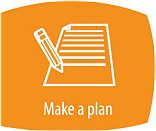
Everyone needs an emergency plan. It will help you and your family know what to do if an emergency should occur.
Every Canadian household needs an emergency plan. It will help you and your family know what to do in case of an emergency. Your family may not be together when an emergency occurs. Plan how to meet or how to contact one another, and discuss what you would do in different situations.
To create your own plan, visit the Public Safety and Emergency Preparedness ‘Make an Emergency Plan’ website.
- It will take you about 20 minutes to make your family emergency plan online
- Keep this document in an easy-to-find, easy-to-remember place (for example, with your emergency kit). Photocopy this plan and keep it in your car and/or at work.
Create a communications plan
A communications plan is a key element of your personal and family emergency preparedness plan. Consider and plan how you will communicate in different situations. Below are some ideas for establishing a communications plan.
Know your numbers
- Compile contact information for your family members, friends and out-of-area contacts so that you can reach them at home, at work, on their cell phone, by email and on social media.
- Maintain a list of phone numbers for local emergency services (e.g. police and fire services, as well as hospitals) in case 911 services are not available.
- Program your cell phone with emergency contacts and keep a paper copy in your emergency kit, on the fridge and in an accessible place like your wallet or purse in case you’re not a home in an emergency.
- Consider creating a group called In Case of Emergency or Emergency Contacts in your cell phone. If you are in an accident, emergency personnel may check your cell phone to reach someone you know.
- For children, designate someone for them to contact if they cannot reach their family members.
- If you are new to Canada or have recently moved to a new area, make arrangements through friends, cultural associations, and community organizations so that someone knows how to contact you.
Keep informed
- Identify key websites for finding out what is happening and what to do in an emergency. Your municipality and province’s websites as well as police and emergency management websites provide valuable information on threats and may offer alert services or post information for citizens during a disaster.
- Download mobile apps to your cell phone and subscribe to text and email alerts that let you know about bad weather, road closures and local emergencies.
Know where to meet
Your family may not be together when a disaster strikes, so set up physical and virtual meeting places.
- A virtual meeting place can be a social media site or voice mailbox. Family members and friends can leave messages about their status and arrange to meet in person.
- A physical meeting place is where you go once it is safe to do so in the event that you are unable to communicate.
- Appoint an out-of-town contact. This contact should live far enough away not to be affected by the same disaster. Family members and friends can contact that person with their status and plans to meet. An out-of-town contact can relay messages between your family and friends, allowing you to turn your attention to more immediate problems.
Build a communications kit
As part of your emergency preparedness kit, here are some tools to consider. Store them in a dry, accessible place, keeping in mind that you may be away from home when a disaster occurs.
- Keep a copy of your plan in your emergency preparedness kit and on the fridge, and provide one to each of your family members. Consider putting a copy in your children’s backpacks, as well in your wallet, purse or briefcase.
- Maintain a home phone that does not require an electrical outlet. Traditional phone service may work during power outages, but you may need to use a corded phone. Most cordless phones rely on electric power to operate. If you have a newer phone service that works on battery back-up equipment during an outage, consider having a spare battery. If you are unsure what kind of service you have, ask your service provider.
- Keep an extra battery for your cordless phone, cell phone or non-traditional phone service. Find out how long your batteries last, keep them charged, learn how to replace them, and regularly test your back-up batteries.
- Stock a cell phone charger that isn’t dependent on electrical outlets, such as a car, solar-powered or crank charger. If you plan on using your car to charge your cell phone or listen to the news, exercise caution. Don’t try to reach your car if it is not safe to do so, and be careful of carbon monoxide emissions from your car, especially if it is in an enclosed space.
- Stock a battery-operated radio that can keep you informed in case of emergencies on public safety issues and evacuation notices. Consider keeping a battery-operated, solar-powered or hand-cranked radio or digital portable television for use during power outages. Make sure to have charged or fresh batteries. Some hand-cranked radios can also be used to charge cell phones, but check the user manual before assuming this is the case.